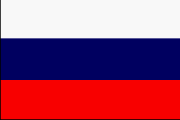





The first Soviet SLBM, the liquid-propellant missile R-11FM, was a modified version of the R-11 Scud-A. This single-stage missile with a nonseparable warhead was equipped with a single-chamber liquid rocket engine and a pressurized fuel supply system. Flight control was accomplished with control jet motors and four aerodynamic stabilizers. The missile was deployed in a dry tube that penetrated the hulls of the submarine. The launch was conducted from the surface, prior to which the missile was elevated to the edge of the tube and fixed with the help of special racks. Unlike the R-11, the R-11FM featured a hermetically sealed instrumental and propulsion compartment and a command stucture capable of receiving data from the navigation system of the submarine on launch..
The development of the R-11FM was authorized by the government on 26 January 1954. S.P. Korolev who was at that time chief designer of OKB-1 NII-88 was assigned the development of the D-1 launch system and the R-11FM missile. Other institutions working on the project included: NII-885 Minraliopoma (command structure, chief designer N.A. Pilyugin), OKB-2 HII-88 (propulsion systems, chief designer A. M.Irayev), NII-49 (navigation systems, director N.A. Charin), МNII-1 (navigation systems, director E.I. Ellyer), OKB-34 (creation of the dynamic platform, chief designer Ye. G. Rudyak).
The development of the R-11FM missile was carried out in three phases. The first two took place at the State Central Taining Site Number 4 at Kapustin Yar, during which the missile was launched from a fixed and then from a dynamic platform. . During September and October 1954 three missiles were launched from a fixed platform similar to the designated submarine launcher. Between 25 May and 30 July 1955 a total of 11 launches were conducted from a dynamic platform. The third phase of tests were carried out on a submarine The first submarine launch was successfully completed on 16 September1955, from the submarine "B-67" of the V-611 (Zulu) class, located in the White Sea close to the Kola peninsula. Seven of the eight tests between 16 September and 13 October 1955 were successful.
In August 1955 the R-11FM project was transferred to SKB-385 in Zlatoust. Chief designer V.P. Makyeyev of SKB-385 was responsible for creating the design documentation, conducting modifications and and flight tests, to adjust series production and to deliver the missile.
To ensure combat readiness after long periods of on-board storage, service tests of the missile and launch system were conducted in August and October 1956 by the Northern fleet. The first long-range patrol of the "B-67" submarine with R-11FM missiles began on 16 August 1956. Covering a route through the White and Barents seas, the boat sailed surfaced and submerged at various speeds, spending two days on alert and conducting missile fiings afterwards. On 12 September and 03 October 1956 missiles that had been stored onboard the submarine for 37, 47 and 82 days were successfully launched.
After these tests, OKB-1 participated in the improvement of the missile and acted as architectural supervisor whereas SKB-385 assumed responsibility for all further activities. The missile documentation was completed in late 1956 and preparation for serial production was initiated. In 1957 manufacturing of propulsion systems and missiles to be tested from a fixed platform began. After they were completed the missile was test-launched from a dynamic platform in the autumn of 1957. The last test phase between March and May 1958 consisted of four submarine launches, of which three were successful.
Deployment of the R-11FM missile began on 20 February 1959 on the 611AB [ZULU V] and 629 [GOLF I] class submarines.
Although the R-11FM missiles were designed to use RDS-4 nuclear explosives, it is reported that during regular patrols they were not equipped with nuclear explosives. The nuclear warheads were stored at the coast, to be transferred to the submarines in times of crisis. Between 1958 and 1967 a total of 77 missile firings were conducted of which 59 were successful. In 1967 the D-1 launch system and the the R-11FM missiles were withdrawn from operational service.
Western intelligence in the 1960s was evidently somewhat confused by the relationship between the R-11FM and R-13 programs. Despite the differences in the physical designs of these missiles, the R-11FM was regarded as simply the interim reduced-range version of the longer range R-13 follow-on.
Specifications |
||
|
DIA |
SS-1b |
|
|
NATO |
Scud |
|
|
Bilateral |
||
|
Service |
R-11FM |
|
|
OKB/Industry |
8K11/8A61FM |
|
|
Design Bureau |
OKB-1 NII-88/SKB-385 |
|
|
Approved |
||
|
Years of R&D |
||
|
Engineering and Testing |
||
|
First Flight Test |
||
|
IOC |
||
|
Deployment began |
2/20/1959 |
|
|
Launch system |
D-1/D-2 |
|
|
Submarine |
611 AB Zulu V |
|
|
Type of Warhead |
Single, inseparable |
|
|
Warheads |
1 |
|
|
Yield (mt) |
0.1/0.5 |
|
|
Payload (t) |
975-1000 |
|
|
Total length (m) |
10.3 |
|
|
Total length w/o warhead (m) |
||
|
Missile Diameter (m) |
0.88 |
|
|
Launch Weight (t) |
5.4-5.6 |
|
|
Fuel Weight (t) |
||
|
Range (km) |
150/167 |
|
|
CEP (m) (Russian Sources) |
1.5 km on range, 0.75 on azimuth |
|
|
CEP (m) Western Sources) |
||
|
Number of Stages |
1 |
|
|
Warheads Deployed |
||
|
Booster guidance system |
Inertial autonomous |
|
|
Engine Designation |
||
|
Propellants |
Liquid |
|
|
Fuel |
Kerosene T-11 |
|
|
Oxidizer |
20% UDMH 80% Nitrogen Acid |
|
|
Burning time (s) |
||
|
Verniers Thrust Sea Level/Vacuum (kn) |
||
|
Specific Impulse (s) |
||
|
Launching Technique |
Surfaced |
|

